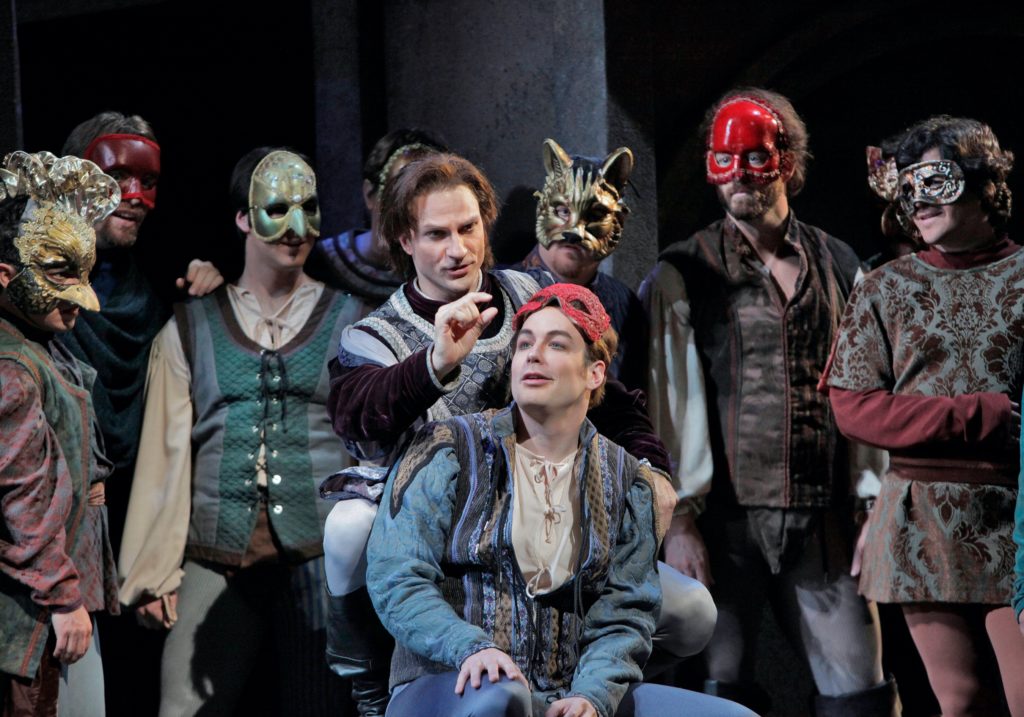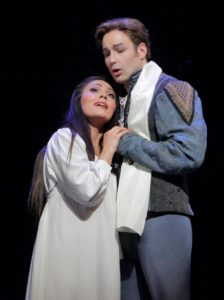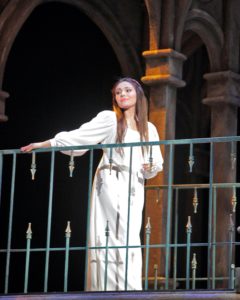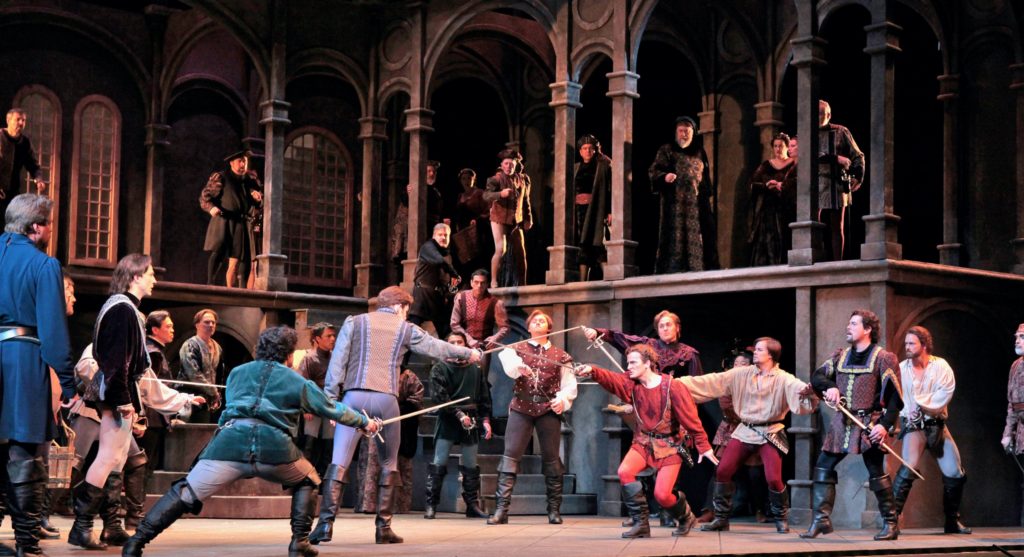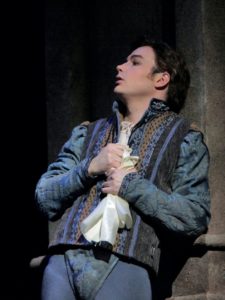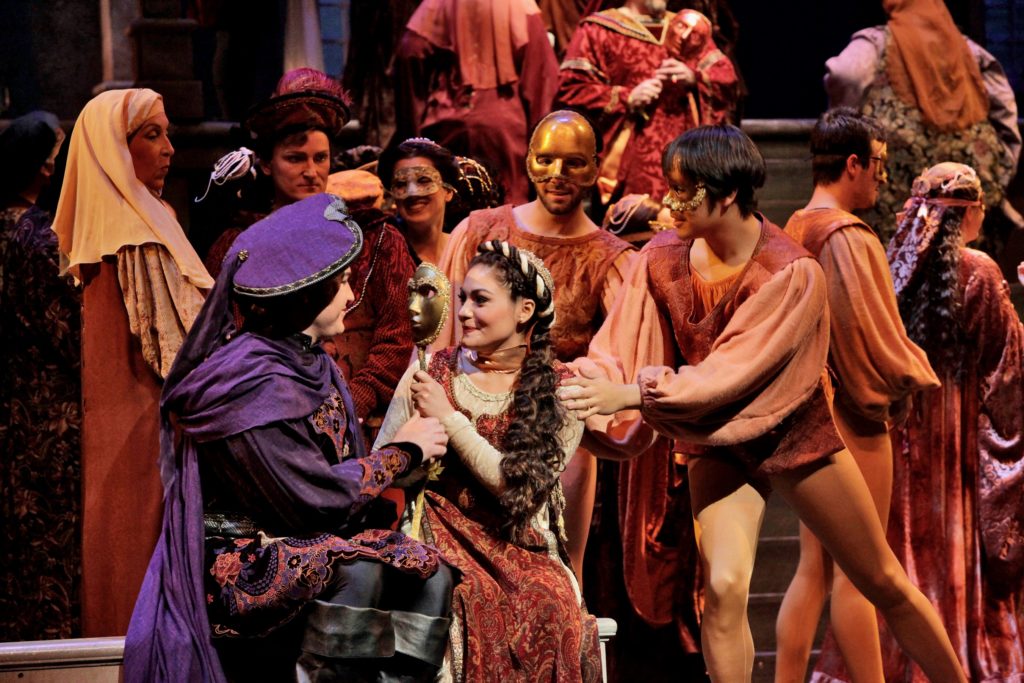Archive for March 2010
Young Stars Shine in San Diego Opera’s “Romeo and Juliet”
San Diego: Sunday, March 14, 2010
Review by David Gregson
What was the meaning of the rapturous applause which greeted the sets and costumes at curtain rise Saturday, the opening night of San Diego Opera’s revival of Gounod’s “Roméo et Juliette”? Were patrons of a certain age suddenly swept back to the 1950’s at the Globe’s Shakespeare Festival in Balboa Park? The whole production evoked something of that look – an all-purpose two-level Renaissance era stage that might have been used for anything written by the Bard. But, borrowed from the Utah Opera, these sets and period costumes (Eric Fielding/Susan Memmott-Allred) were actually a bit dispiriting, redolent as they were of recession era budgetary necessity.
It would have been nice to complement an exceptional cast with an exceptional looking production, but this was not to be the case. The wonderful singing actors, many of them young Americans, showed us how far opera training has come these days. Performers now routinely do things rarely seen or dreamt of in the Golden Age (whatever that age may be for you). The sword fights alone were remarkable, even if they also seemed carefully choreographed. These fights (directed by Dale Girard) were among the best I can recall seeing on the opera stage – and yes, they too reminded me of the Globe, but in a good way. I loved those shows in the ‘50s and ‘60s.
 Reading an audience’s reactions is always a puzzling challenge, of course. When American soprano Ailyn Pérez as Juliet sang her famous arietta in Act One (“Ah! Je veux vivre dans le rêve”) she received a healthy and well-deserved round of appreciation from the crowd. Here was an a obviously gifted, good looking young woman with a lustrous timbre to her voice, warbling away as Gounod’s innocent heroines are wont to do before times get tough. A little strain on top, but really nice. Yet when Pérez absolutely aced the heavier stuff in the poison-potion scene of Act Three, the standing ovation her simging should have received never materialized. Pérez is perfect for this role. Some say it’s a role for two different voices: she has them both.
Reading an audience’s reactions is always a puzzling challenge, of course. When American soprano Ailyn Pérez as Juliet sang her famous arietta in Act One (“Ah! Je veux vivre dans le rêve”) she received a healthy and well-deserved round of appreciation from the crowd. Here was an a obviously gifted, good looking young woman with a lustrous timbre to her voice, warbling away as Gounod’s innocent heroines are wont to do before times get tough. A little strain on top, but really nice. Yet when Pérez absolutely aced the heavier stuff in the poison-potion scene of Act Three, the standing ovation her simging should have received never materialized. Pérez is perfect for this role. Some say it’s a role for two different voices: she has them both.
In real life Pérez is actually married to her Romeo, American tenor Stephen Costello, an interesting artist who is difficult to evaluate fairly on one hearing. He has a strong, masculine tenor voice, not of the sweet and lyrical variety. He projects his voice well, and he can affect an Italianate sob where appropriate, and he trumpets certain notes with such authority that he is often reluctant to let them go. Conductor Karen Keltner (who led the San Diego Symphony’s forces fairly smoothly through the evening with some stray glitches here and there) appeared to slow down from time to time to accommodate a note value Costello relished. Showing off can be a good thing for tenors: no complaints there. Romeo is clearly a good role for him, and it doesn’t hurt that he can cut a dashing figure on stage when he chooses to. There is a curious, indefinite aspect to his stage persona.
One might argue his tender moments were less effective than his heroic ones, but in general Costello was up to all challenges: “Ah! Lève toi, soleil!” the second act finale, and all four “love duets” in which his voice blended beautifully with that of his real-life spouse. You can see many of his opera hits on You Tube.
The dashing American – er, I mean, Texan baritone (his joke, not mine) was David Adam Moore, who impressed with his big number about the mythical Queen Mab and with his death scene, and – of course – with his Douglas Fairbanks impressions in his fatal swordfight. He was well matched with another virile customer, American tenor Joel Sorenson as Tybalt. Both men contributed mightily to the success of the production.
But, truly, there are no weak links when you have American bass Kevin Langan as Friar Laurence, American bass-baritone Paul Hindemith as Count Paris, American mezzo-soprano Suzanna Guzmán as Gertrude (the Nurse), American baritone Malcolm MacKenzie as Gregorio, American bass-baritone Scott Sikon as Capulet (are you saluting the flag yet?), plus one terrific New Zealander, mezzo-soprano Sarah Castle in the almost-but-not-quite thankless trouser role of the page Stephano – a character who gets a memorable aria about turtledoves and vultures.
I am assuming the imposing bass-baritone Philip Skinner is an American too, though the program bio is not clear on this point. He’s most certainly a Merola grad and has been in San Francisco a good deal. At any rate, he made a fine Duke of Verona while doubling as Friar John. Taiwanese tenor Joseph Hu was a highly effective Benvolio. Although Hu first came to San Diego in 1995, one remembers him as being somewhere in absolutely everything.
The chorus gave its usual excellent performance under the direction of chorus master Timothy Todd Simmons. Lighting designer Ruth Hutson made sure that most of the time you could see the principals in the nocturnal scenes, although Romeo’s dark colors tended to acted as camouflage when he stood too close to Juliet’s balcony.
Stage director Cynthia Stokes made the most out of the sets and costumes without complaint and affected some gratifyingly seamless shifts between scene changes. No waiting around, thank goodness. Although nothing she did was revelatory, it was mostly appropriate to the action and well judged. Juliet’s first entrance was odd because her costume did not flatter her (so you could not see what was causing the chorus to keep saying, “Oh, how beautiful she is!”) – but it made sense to come in at the top of the staircase. There might have been a more interesting creative solution to this entrance and to many other things in the opera, but the direction as a whole “worked.”
The opera, incidentally, has been trimmed and rearranged in various ways, although the only thing I really missed was the choral prologue. You can eliminate the ballet with no harm to anything; however, even though Gounod added the prologue as an afterthought, that bit is important to placing emphasis on Shakespeare’s real theme: the irrational and “continuous rage” of the rival families, the Capulets and the Montagues (into which you may read the name of any warring factions you care to.) The lovers are doomed by this hatred.
Romeo and Juliet are the sacrificial victims of endless conflict. Shakespeare ends his work with the forced reconciliation of the families. So does Berlioz, by the way. Even “West Side Story” put its emphasis on the gang clashes. But when the lovers are dead in Gounod’s opera – CURTAIN! No solution to the problem. The opera’s missing prologue would point in the right direction – although admittedly mostly by indirect reference to Shakespeare’s, which tells the entire story (including the end of the family conflict) in the form of a sonnet:
Two households, both alike in dignity,
In fair Verona, where we lay our scene,
From ancient grudge break to new mutiny,
Where civil blood makes civil hands unclean.
From forth the fatal loins of these two foes
A pair of star-crossed lovers take their life;
Whose misadventured piteous overthrows
Do with their death bury their parents’ strife.
The fearful passage of their death-mark’d love,
And the continuance of their parents’ rage,
Which, but their children’s end, nought could remove,
Is now the two hours’ traffic of our stage;
The which if you with patient ears attend,
What here shall miss, our toil shall strive to mend.
Charles Gounod: “Roméo et Juliette”
San Diego Opera
Civic Theater
Saturday, March 13, 7 p.m.
Tuesday, March 16, 7 p.m.
Friday, March 19, 8 p.m.
Sunday, March 21, 2 p.m.
The Cast
Juliet: Ailyn Pérez
Romeo: Stephen Costello
Mercutio: David Adam Moore
Tybalt: Joel Sorensen
Friar Laurence: Kevin Langan
Stephano: Sarah Castle
Capulet: Scott Sikon
Gregorio: Malcolm MacKenzie
Gertrude:Suzanna Guzmán
Benvolio: Joseph Hu
Duke of Verona/Friar John: Philip Skinner
Count Paris: Paul Hindemith
Conductor: Karen Keltner
Director: Cynthia Stokes
Choreographer: Keturah Stickan
Scenic Designer: Eric Fielding
Costume Designer: Susan Memmott-Allred
Lighting Desinger: Ruth Hutson
Fight Director: Dale Girard
Wig and Makeup Designer: Steven W. Bryant
Chorus Master: Timothy Todd Simmons

